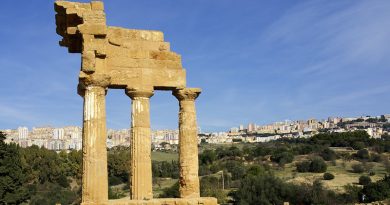Hidden Naxos
Naxos is the largest island in the Cyclades group in Greece, but also less touristed and more traditional than others in the group.
Known for its beautiful and often deserted beaches, mountainous landscapes and fertile plains, it is both a breadbasket among Greek islands and an attractive destination to explore historic sites from the Venetian and Ancient Greek eras.
Most ferries arrive in Naxos Town ,or Chora, the main settlement on the island.

Portara, known as the Temple of Apollo is an iconic marble doorway on the islet of Palatia, linked to Naxos town by a causeway. It’s the remnant of an unfinished temple dedicated to Apollo.
The Archaeological Museum of Naxos housed in a former Jesuit school I Naxos Town, features artifacts from the Neolithic to early Christian periods.
Elsewhere there are numerous Ancient Greek sites on the island.

The Sanctuary of Demeter is a a well-preserved 6th-century BC temple near Sangri village, dedicated to the goddess of agriculture. It is situated in a superb setting overlooking a fertile valley in the centre of the island .It is made of the brilliant white Naxos marble.
Naxos’ quarries have mined precious high quality marble in its mountains and hillsides since ancient times.
The Kouros of Apollonas is massive unfinished ancient statue (10.5m long) lying in a quarry near Apollonas village, on the far northeastern tip
of the island.
The Kouros of Melanes (Flerio Kouros) is another unfinished ancient statue located near Melanes village.
Naxos also has numerous sites reflecting its Venetian heritage . The island was controlled by Venetian dynasties for more than 300 years from the time of the Fourth Crusade in 1204.
Naxos Castle (Kastro) is a a medieval fortress in Naxos Town (Chora), built by the Venetians in the 13th century. Inside, you find The Venetian Museum (Della Rocca-Barozzi) showcasing Venetian aristocratic life.

Bazeos Tower is a restored 17th-century monastery and fortress near Sangri, now hosting cultural events. There are numerous ruins of Venetian towers scattered around the coast of Naxos. The island was an important settlement on its trading routes across the Mediterranean and the towers were defensive fortifications used to watch out for and ultimately protect its vast shipping fleets.
Naxos’ traditional villages are worth a visit.
Apeiranthos is a picturesque mountain village with marble-paved streets and small museums.
Filoti is a charming village with whitewashed houses and the Church of Panagia Filotitissa.

Halki (Chalki) A former capital with neoclassical mansions and the Vallindras Distillery (famous for Kitron liqueur). Koronos is a scenic village known for its citrus groves and hiking trails.
Destination: Greece and Greek Islands




